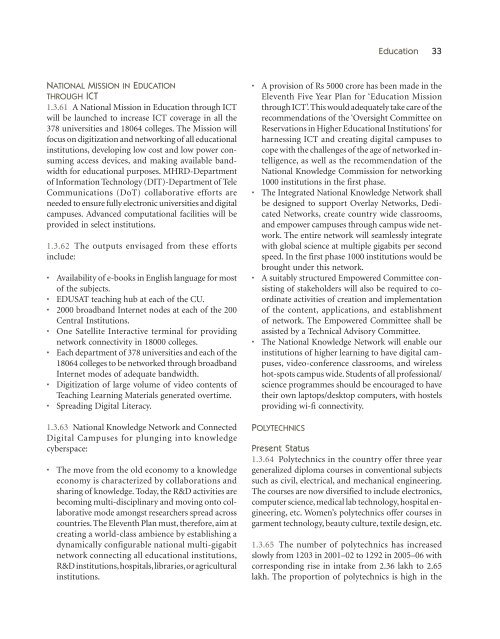Eleventh Five Year Plan
Eleventh Five Year Plan
Eleventh Five Year Plan
You also want an ePaper? Increase the reach of your titles
YUMPU automatically turns print PDFs into web optimized ePapers that Google loves.
Education 33NATIONAL MISSION IN EDUCATIONTHROUGH ICT1.3.61 A National Mission in Education through ICTwill be launched to increase ICT coverage in all the378 universities and 18064 colleges. The Mission willfocus on digitization and networking of all educationalinstitutions, developing low cost and low power consumingaccess devices, and making available bandwidthfor educational purposes. MHRD-Departmentof Information Technology (DIT)-Department of TeleCommunications (DoT) collaborative efforts areneeded to ensure fully electronic universities and digitalcampuses. Advanced computational facilities will beprovided in select institutions.1.3.62 The outputs envisaged from these effortsinclude:• Availability of e-books in English language for mostof the subjects.• EDUSAT teaching hub at each of the CU.• 2000 broadband Internet nodes at each of the 200Central Institutions.• One Satellite Interactive terminal for providingnetwork connectivity in 18000 colleges.• Each department of 378 universities and each of the18064 colleges to be networked through broadbandInternet modes of adequate bandwidth.• Digitization of large volume of video contents ofTeaching Learning Materials generated overtime.• Spreading Digital Literacy.1.3.63 National Knowledge Network and ConnectedDigital Campuses for plunging into knowledgecyberspace:• The move from the old economy to a knowledgeeconomy is characterized by collaborations andsharing of knowledge. Today, the R&D activities arebecoming multi-disciplinary and moving onto collaborativemode amongst researchers spread acrosscountries. The <strong>Eleventh</strong> <strong>Plan</strong> must, therefore, aim atcreating a world-class ambience by establishing adynamically configurable national multi-gigabitnetwork connecting all educational institutions,R&D institutions, hospitals, libraries, or agriculturalinstitutions.• A provision of Rs 5000 crore has been made in the<strong>Eleventh</strong> <strong>Five</strong> <strong>Year</strong> <strong>Plan</strong> for ‘Education Missionthrough ICT’. This would adequately take care of therecommendations of the ‘Oversight Committee onReservations in Higher Educational Institutions’ forharnessing ICT and creating digital campuses tocope with the challenges of the age of networked intelligence,as well as the recommendation of theNational Knowledge Commission for networking1000 institutions in the first phase.• The Integrated National Knowledge Network shallbe designed to support Overlay Networks, DedicatedNetworks, create country wide classrooms,and empower campuses through campus wide network.The entire network will seamlessly integratewith global science at multiple gigabits per secondspeed. In the first phase 1000 institutions would bebrought under this network.• A suitably structured Empowered Committee consistingof stakeholders will also be required to coordinateactivities of creation and implementationof the content, applications, and establishmentof network. The Empowered Committee shall beassisted by a Technical Advisory Committee.• The National Knowledge Network will enable ourinstitutions of higher learning to have digital campuses,video-conference classrooms, and wirelesshot-spots campus wide. Students of all professional/science programmes should be encouraged to havetheir own laptops/desktop computers, with hostelsproviding wi-fi connectivity.POLYTECHNICSPresent Status1.3.64 Polytechnics in the country offer three yeargeneralized diploma courses in conventional subjectssuch as civil, electrical, and mechanical engineering.The courses are now diversified to include electronics,computer science, medical lab technology, hospital engineering,etc. Women’s polytechnics offer courses ingarment technology, beauty culture, textile design, etc.1.3.65 The number of polytechnics has increasedslowly from 1203 in 2001–02 to 1292 in 2005–06 withcorresponding rise in intake from 2.36 lakh to 2.65lakh. The proportion of polytechnics is high in the












![[Tam] Uygula[ya] - Bilim, Teknoloji ve Ä°novasyon Politikaları TartıÅma ...](https://img.yumpu.com/36820041/1/184x260/tam-uygulaya-bilim-teknoloji-ve-anovasyon-politikalara-tartaama-.jpg?quality=85)



